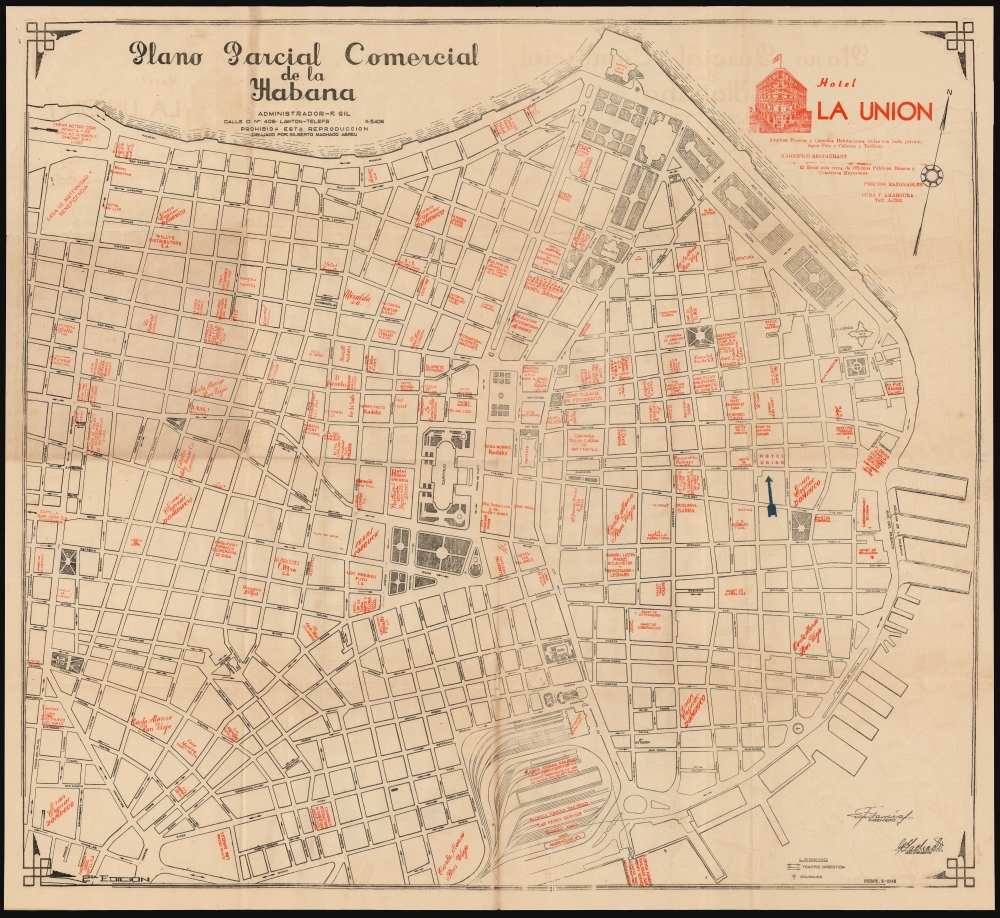This item has been sold, but you can get on the Waitlist to be notified if another example becomes available, or purchase a digital scan.
1948 Gilberto Machado Abreu Map of Central and Old Havana
Havana-machado-1948$625.00

Title
Plano parcial comercial de la Habana.
1948 (dated) 25 x 27 in (63.5 x 68.58 cm) 1 : 4000
1948 (dated) 25 x 27 in (63.5 x 68.58 cm) 1 : 4000
Description
This is a rare and fascinating 1948 map of the commercial center of Havana, Cuba, printed there by Gilberto Machado Abreu for the use of English-speaking tourists and businessmen. It reveals a plethora of businesses catering to visitors of the city, from hotels to drug stores to record stores to photographers, providing a fascinating glimpse of the city during the Republican period prior to Batista's 1952 coup. It is the Havana that would have been familiar both to Ernest Hemingway, and to Graham Greene.
The map is printed in three colors. The parks, major edifices of the city, churches and roads are printed in black: this includes arrows indicating the direction of traffic on each street (a most helpful feature, as most of Havana's roads are to this day narrow one-way streets). Printed in red are the advertisement for the Hotel La Union in the upper right, as well as the map's many hotels, restaurants and other businesses. An arrow in deep blue points out the location of Hotel La Union on the map. Instructions and descriptive text is predominantly in English.
The Commercial Heart of Havana
The map focuses on Old Havana and the Centro; bounded in the north by the city's Malecon, and on the east by its harbor terminals. It reaches as far west as the via Marques Gonzales and as far south as Diaria and the rail terminal. The Capitol building is at the center of the map, surrounded by its business district.The map is printed in three colors. The parks, major edifices of the city, churches and roads are printed in black: this includes arrows indicating the direction of traffic on each street (a most helpful feature, as most of Havana's roads are to this day narrow one-way streets). Printed in red are the advertisement for the Hotel La Union in the upper right, as well as the map's many hotels, restaurants and other businesses. An arrow in deep blue points out the location of Hotel La Union on the map. Instructions and descriptive text is predominantly in English.
Our Map in Havana
Cuba's Republican period saw massive development, and by the thirties and forties had become a well-off country, with the third largest middle class in the western hemisphere. Along with mansions and apartment buildings, Havana exploded with luxury hotels, casinos and nightclubs. When British author Graham Greene wrote in the first outlines in 1946 of the story that would become Our Man in Havana, it had been initially set in Estonia. However, Greene's visits to Havana in the early 1950s convinced him that Havana, with its bars and opulent hotels would be a better setting for that spy farce. The Havana depicted on the present map, being but a few years earlier, would have been very familiar both to Greene and to the denizens of the city in his novel. The Hotel Sevilla (in whose room 501 Greene's protagonist is introduced to the world of espionage) is named on the map, as is the famous Hotel Ingliterra, Greene's reputed favorite haunt.What, No Floridita?
There were more hotels, bars, and theaters active in 1948 than might be suggested by this map! It is most likely that Machado funded the production of his maps by receiving subscriptions from commercial sponsors who would pay to have their businesses appear on the map. The individual titles in red appear to have been movable and interchangeable: the example of this map located at the University of Pennsylvania, for example, appears to be identical as far as the black printed map is concerned, but the advertisement in the upper right is for the Hotel Bristol, not Hotel La Union as here. The example cataloged at Jose Marti in Havana carries an advertisement for the H. H. Pike Trading company. The sort of changes exemplified by the main advertisement in the upper right must also have taken place throughout the map's smaller placements.Hotel La Union
The primary sponsor of this particular map, commanding the large space in the upper right, was the illustrious Hotel La Unión. In the first half of the twentieth century, this was among the largest and most prestigious hotel in the Republic. It was founded in 1846, but the structure pictured here was built in 1911. It was an extravagant building at number 55 Cuba Street, fully electrified with elevator service to its five stories and telephones in each of its 120 rooms. It boasted service in English and French to entice European and American visitors. The hotel's restaurant, cafe, and canteen were popular for its meals and fine wines. Poet and Playwright Federico García Lorca stayed there for three months in 1930.Publication History and Census
This map was produced in 1948 by Gilberto Machado Abreu as a separate issue; it is the mapmaker's only known work, and there is no biographical information available for him. (There are several Gilberto Abreus who appear in the United States in later years, but there are no convincing candidates among them.) We are aware of only three institutional examples of this map: one in the University of Miami Cuban Heritage Collection, the example at Penn State, and a possible example in the Jose Marti National Library in Havana. We have seen no other examples on the market, and there are no auction or catalog records for this map. Owing to the changeability of the advertising matter in this map, each surviving example appears to be unique.Condition
Good. Worn at folds with few areas of loss, else very good and attractive.
References
OCLC 58532314.

